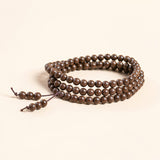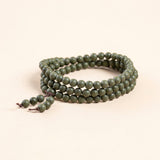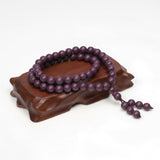Listening for the Quiet Beneath the Noise
Have you ever had a gut feeling that something was off, but your anxious brain immediately jumped in to argue with it?
Maybe you felt uneasy about a new opportunity, but you over-analyzed it until logic convinced you to say yes.
Or maybe you sensed that a friend wasn’t being truthful, but you brushed it off because you didn’t want to seem paranoid.
That tug-of-war between intuition and anxiety is exhausting.
When anxiety is loud, it drowns out the gentle voice of instinct — the one that whispers, not shouts. And yet, your intuition is one of the most trustworthy guides you have.

At Kenlina, we believe calm doesn’t silence your thoughts — it helps you hear the right ones.
Just like our natural wood and herbal incense bracelets remind you to pause and breathe, reconnecting with intuition is about slowing down enough to notice what’s underneath the noise.
You don’t have to fight your anxious mind; you can learn to work with it.
Here’s how.
Understanding What Intuition Really is?
Intuition isn’t magic or superstition.
It’s your brain making rapid connections — blending memories, emotions, and subtle cues before your conscious mind has time to analyze.
It’s pattern recognition at lightning speed, built from experience.
That flutter in your chest before making a choice?
That’s data — processed through feeling.
Psychologists call it unconscious reasoning: your mind quickly linking past experiences to current circumstances.
Think of intuition as a quiet internal compass, one you can access only when you’re still enough to listen.
It’s not about guessing; it’s about remembering what you already know, but forgot you knew.
Why Anxiety Makes Intuition Hard to Hear?
Anxiety is loud. It demands attention.
Its job is to keep you safe — but it often confuses safety with control.
When your mind is scanning for every possible risk, intuition gets pushed into the background.
People with high-functioning anxiety know this well:
- You overthink every decision.
- You second-guess gut feelings.
- You crowd out inner wisdom with constant “what ifs.”
An anxious brain wants certainty; intuition thrives in uncertainty.
The more you chase proof, the less you can hear instinct.
The goal isn’t to silence anxiety — it’s to differentiate it.
Anxiety yells in fear; intuition whispers in clarity.
Learning which voice is speaking is where calm begins.
The Body Knows Before the Brain Does

Intuition doesn’t live in your thoughts — it lives in your body.
The gut tightens when something feels off. The chest expands when something feels right.
Before your mind rationalizes, your body reacts.
Start paying attention to these cues:
- Tension may signal misalignment.
- Ease often signals truth.
- Energy drop can mean resistance; energy rise can mean readiness.
The next time you’re faced with a choice, notice how your body responds before your brain tells its story.
Touch your Kenlina bracelet as you do — feel the texture of the beads, the weight against your skin.
Sometimes grounding in your senses is enough to quiet mental chatter long enough to recognize what your body already knows.
Anxiety vs. Intuition - How to Tell the Difference?
It helps to name what each voice sounds like.
| Anxiety | Intuition | |
| Tone | Loud, urgent, repetitive | Calm, clear, matter-of-fact |
| Emotion | Fearful, pressured | Neutral, confident |
| Focus | What might go wrong | What feels aligned |
| Need | Constant reassurance | Quiet certainty |
| Effect | Drains energy | Brings peace |
Example:
- Anxiety says, “What if they’re upset with me?”
- Intuition says, “That conversation didn’t feel balanced.”
Anxiety seeks control; intuition seeks truth.
When you feel calm curiosity rather than panic, you’re likely listening to the right voice.
Past Experiences Shape Both Voices
Intuition grows from experience — but so does anxiety.
Every time you’ve been hurt, embarrassed, or rejected, your brain builds protective patterns.
Sometimes those patterns help; sometimes they distort.
That’s why self-awareness matters.
When you reflect on past experiences, ask:
- “What was intuition last time — and what was fear?”
- “When did I ignore my gut and regret it?”
- “When did I follow it and feel relieved?”
Your intuition keeps score quietly.
The more you notice its patterns, the more confidence you build in its accuracy.
Six Gentle Practices to Reconnect with Intuition
Intuition doesn’t return through force; it returns through softness.
Here are six small, mindful ways to rebuild trust with it.

1. Quiet the Mind to Hear the Whisper
Intuition speaks only in silence.
You don’t need an hour of meditation — two minutes of stillness is enough.
Try this:
Close your eyes, take a slow breath, and listen for what comes up before your inner critic interrupts.
It might be a word, an image, or just a feeling. That’s intuition saying hello.
When in doubt, hold your bracelet and let its rhythm remind you to slow your pace — bead by bead, breath by breath.
2. Listen to the Body Before the Mind
Your body doesn’t lie, even when your thoughts do.
When making a decision, ask:
- Does this feel expansive or heavy?
- Light or tight?
- Peaceful or pressured?
Your nervous system registers truth faster than logic can explain it.
Calm the body, and the answer will surface naturally.
3. Start Small
Don’t begin with life-changing decisions.
Practice intuition in low-stakes moments — picking a meal, choosing a route home, sending that text.
Notice what feels right and what doesn’t.
Each small success rebuilds trust in your inner voice.
You’re not training intuition itself; you’re training your faith in it.
4. Write the Dialogue Between Fear and Intuition
Grab a notebook and write two columns.
Label one “Anxiety,” the other “Intuition.”
Ask a question — say, “Should I take this opportunity?”
Then, write what each side says.
You’ll see it clearly:
Anxiety fills the page with “what if.”
Intuition answers in one short sentence that feels steady.
Seeing the two voices side by side turns confusion into clarity.
5. Stop Asking Everyone Else
The more you poll others, the less you hear yourself.
Advice has its place, but intuition doesn’t need a focus group.
Next time you’re tempted to text five friends for opinions, pause.
Ask yourself: “What do I already know?”
The answer’s usually there — buried under noise and doubt.
Remember: external validation is temporary; internal alignment lasts.
6. Pair Breath With Awareness
Every breath is a reset button.
When fear rises, place a hand over your heart or feel the weight of your bracelet.
Inhale through the nose, exhale through the mouth, and silently say:
“I trust what I feel.”
Repeat until your breath slows and your mind softens.
You’ll notice intuition arrives not as words, but as ease.
Finding Calm before Clarity
People often say, “I’ll relax once I have the answer.”
But calm isn’t the reward for clarity — it’s the path to it.
When anxiety floods you, the body moves into survival mode.
No amount of logic can help until you return to a state of safety.
So before making any big decision, calm yourself first.
Breathe. Stretch. Step outside.
Run your fingers over each bead of your bracelet like a mindfulness rosary.
By the time you finish, your intuition will be clearer — not because it changed, but because you finally made space for it.
Self-Awareness is the bridge between Fear and Intuition
You can’t separate intuition from self-awareness.
The more you understand your patterns — your triggers, biases, emotional defaults — the easier it becomes to tell which voice is speaking.
Ask gentle questions daily:
- “What am I feeling right now?”
- “Where do I feel it in my body?”
- “Is this reaction about now, or something old?”
Self-awareness turns raw emotion into readable data.
Once you learn your own emotional language, intuition stops feeling mystical and starts feeling like common sense.
When to Trust Intuition and When to Wait?
Intuition is powerful, but not infallible.
If you’re exhausted, grieving, or running on caffeine and adrenaline, your instincts might blur with impulse.
Trust intuition when:
- You feel calm and grounded.
- The message feels consistent, not frantic.
- Your body relaxes when you consider the choice.
Wait or double-check when:
- You’re emotionally charged.
- You’re seeking validation for what you want to be true.
- Your “gut” feels tense rather than steady.
Balance is key. Let logic confirm what intuition whispers — they’re teammates, not rivals.
Breaking the Habit of Over-Analysis
If you have anxiety, you probably also have a PhD in overthinking.
You research, you plan, you spiral, you freeze. That’s analysis paralysis.
Here’s a gentle experiment:
Next time you’re stuck between choices, pick one small step and act.
Notice what happens inside you.
Does relief flood in? That’s intuition thanking you for trusting it.
Intuition grows stronger when you act on it, not when you analyze it to death.
A Small Kenlina Ritual for Trusting Yourself
At Kenlina, we often pair mindfulness with tangible reminders — touch, texture, scent.
Here’s a one-minute ritual you can try anytime your mind feels noisy:
- Sit somewhere quiet.
- Hold your bracelet in your palm.
- Inhale deeply, counting four beats.
- As you exhale for six beats, roll one bead between your fingers.
- Whisper: “I already know.”
Repeat until your shoulders drop.
This isn’t magic. It’s muscle memory — teaching your body that calm is safe and clarity can return.
Extending Calm Beyond Yourself
Reconnecting with intuition isn’t only about self-trust — it’s also about shared compassion.
When you act from intuition instead of fear, you show up in the world calmer, kinder, more present.
That’s why Kenlina supports the Anxiety and Depression Association of America (ADAA), donating 1% of every purchase to fund awareness, research, and emotional wellness programs.
Every time you wear your bracelet, you’re carrying not just personal calm, but collective care — a reminder that peace multiplies when it’s given.
Trusting Yourself is the Deepest Calm
Your intuition isn’t gone; it’s just been buried under worry.
It doesn’t need to be found — only heard again.
The next time you catch yourself spiraling in “what ifs,” pause.
Breathe.
Ask softly, “What if I already know the answer?”
You’ll feel it — that quiet, grounded yes.
Because underneath anxiety, your intuition has always been waiting.
And underneath both, there’s something even deeper: peace.








